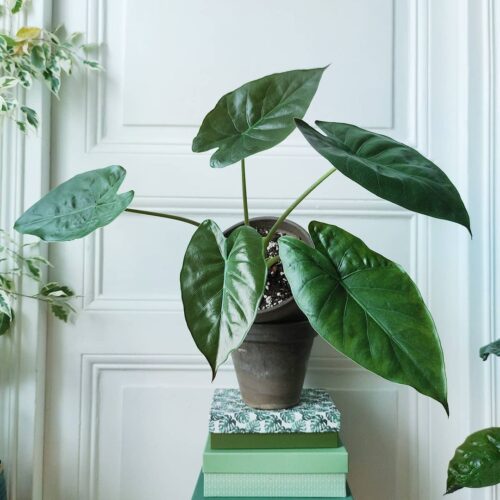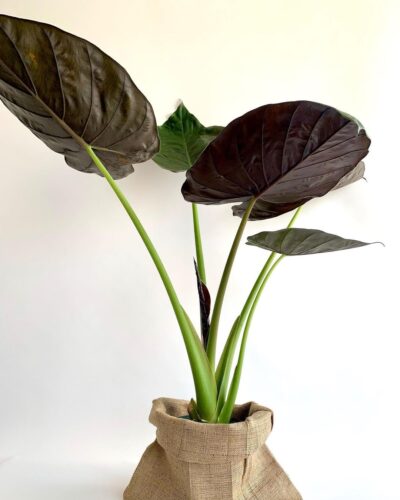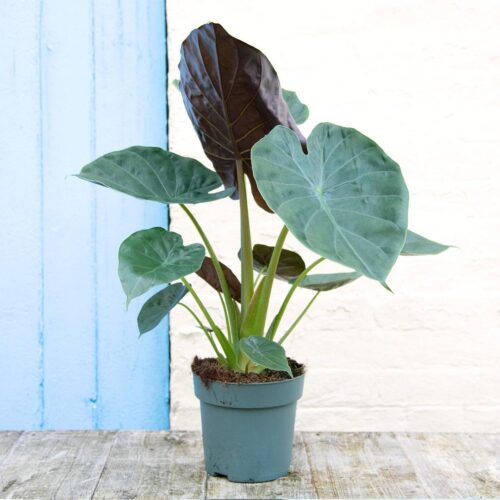Alocasia Wentii can be a beautiful addition to your indoor garden. Learn what this plant needs to flourish in this guide.
Find all the details of Alocasia Wentii care with the best tips and tricks to make your task easier. This attractive plant doesn’t have specific demands; read about its needs and how to fulfill them in this article.
Read about GROWING ALOCASIA JACKLYN
Alocasia Wentii Information

Also known as ‘New Guinea Shield,’ ‘Purple Umbrella,’ or ‘Hardy Elephant Ear,’ Alocasia wentii comes from the highlands of New Guinea. It belongs to the Araceae family. This plant displays ruffled-edges arrowhead-shaped glossy green leaves with purple undersides.
This plant is popular for its vivid color palette. It is believed that Alocasia wentii is a hybrid of Alocasia Ordora and Alocasia Gageana.
In favorable growing conditions, it grows fast and reaches up to 3 feet tall. The broad leaves can extend up to a foot in length. However, it grows well in warm settings and become dormant in cool climate.
Alocasia wentii Flowers
It produces spadix and spathe; the flowers of alocasia wentii are known as an inflorescence and are inconspicuous. This plant is often grown for its beautiful foliage.
Read About MONSTERA LECHLERIANA CARE
How to Propagate Alocasia Wentii
You can propagate Alocasia Wentii from offsets that are pups or small plantlets that grow at the base of the mother plant. Find the details below.
- Remove the pups from the base of the mature plant.
- Carefully divide the plant without damaging the stems or roots.
- Fill the pots with well-draining soil and plant offsets in individual containers.
- Water adequately and keep the pots in an area with bright, indirect light.
- Keep the soil consistently moist but not soggy.
- Mist the plant regularly to maintain the humidity, or use a tray filled with water and pebbles.
Read about COLOCASIA ESCULENTA ‘BLACK CORAL’ CARE
Pot Size for Growing Alocasia Wentii
Use a pot 10-12 inches in diameter, and make sure the container has drainage holes.
Ideal Growing Conditions for Alocasia Wentii

Light
Grow your Alocasia wentii where it receives plenty of bright indirect light. It can tolerate low-light conditions but does not thrive rapidly. Also, when growing this plant outdoors in warm months, keep it in an area with partial shade, as direct sun can scorch the foliage.
Soil
Use well-draining, nutrient-rich soil; add organic matter such as peat moss, shredded leaves, and coco-coir into the potting mix. The potting medium has to be moisture-retentive that also drains excess water.
Note: Repot your alocasia wentii, if the soil is draining too fast. Use compost-rich medium and add fewer drainage components.
Water
Alocasia wentii has average watering needs; this plant doesn’t prefer to dry out entirely but also does not appreciate soggy soil. Allow the topsoil to dry between watering. Always check the soil moisture before watering by inserting a finger in the potting mix; if it comes dry, then it’s time to water the plant.
Also, avoid overwatering as it can lead to root rot. It will be great to water the plant thoroughly until it seeps out from the drainage holes.
Temperature and Humidity
This tropical plant favors warm temperatures between 65-80 F. Keep the plant away from doors and windows during drafts. Also, do not locate the alocasia close to cooling or heating vents.
Alocasia likes humid surroundings up to 50-70 percent; you can place it near a humidifier or put the pot on a pebble tray filled with water.
Check out PHILODENDRON ORANGE MARMALADE CARE
Alocasia Wentii Care

Fertilizer
Alocasia wentii is a heavy feeder. Feed the plant when it is actively growing in spring and summer. Apply 1/4 diluted water-soluble fertilizer with watering every time, as nutrients are washed in containers easily. You can also use fish emulsion or seaweed fertilizer. Avoid feeding the plant in cold months.
NOTE: If you notice leaf burn, it implies overfeeding. In this case, flush the pot with water till it drains from the holes and stop fertilization.
Repotting
Repot Alocasia wentii after the first year at the beginning of the growing season in a 1-2 inches bigger pot with drainage holes. Do remember that this plant likes to be root-bound.
TIP: Avoid repotting alocasia in dormant winter months.
Pruning
Maintain the shape of your alocasia with occasional pruning. Use clean pruning shears and remove dull, dead, yellow, and infected leaves.
Pests and Diseases
Spider mites and mealybugs can affect your alocasia wentii. You can treat the infected plants by using an insecticidal spray. For deterring mealybugs, use neem oil or insecticide.
Root rot and salt buildup can also be an issue in alocasia plants. Avoid overwatering; allow the soil to dry out between watering. Make sure the top 1 inch of soil turns dry before the next watering.
Use non-chlorinated water for watering the plants. You can dechlorinate water by allowing the water-filled bucket to sit overnight and use this water for plants.
Check out GRYPHON BEGONIA Growing and Care Information
Toxicity
This plant is considered toxic to pets and humans. Alocasia leaves contain insoluble calcium oxalate that can cause vomiting, nausea, and diarrhea if ingested. Also, the sap of this plant can lead to skin irritation; hence, wear gloves while pruning or touching the plant.



